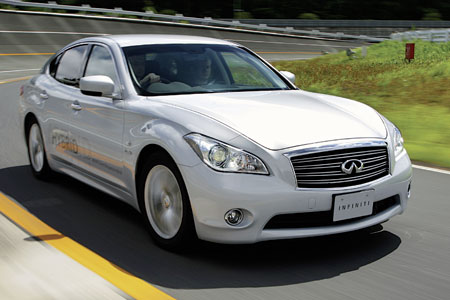Review
After a decade of domination by Toyota, Lexus and Honda, many other manufacturers are in the process of launching hybrid cars.
It is perhaps surprising then that the first alternative to a Toyota or Lexus full hybrid (where a vehicle can be driven on electric power, rather than the motor being just used as a power boost for the engine) is one of the newest car brands in the UK.
The Infiniti M35h pairs a 306bhp 3.5-litre V6 petrol engine with a 68bhp electric motor, resulting in a combined total power output of 364bhp, and giving it the torque to match a powerful diesel engine.
Its 0-62mph sprint time of 5.5 seconds is faster than any other hybrid on sale, and it has an edge over six-cylinder diesel models in its class.
Unlike Lexus whose hybrid models use a CVT, Infiniti has chosen a conventional torque converter automatic gearbox which should have more appeal for driving enthusiasts, and while other manufacturers have adopted electric power steering systems to save fuel, Infiniti uses an electro-hydraulic set-up with a few concessions to efficiency.
In an era where the performance of a car has to be exaggerated by over-size wheels, it’s a strange quirk of the M35h that in view of the need to keep emissions to a minimum, the fastest M car runs on the smallest wheels at 18 inches.
But 18-inch wheels are large enough, although the M’s sweeping profile seems to accentuate its length of almost five metres, a few centimetres longer than an Audi A6, BMW 5 Series or a Mercedes-Benz E-Class.
Step inside the M and it’s hard to imagine a cabin with a more luxurious feel. Leather is the same standard as expensive upgrades on other cars, while a powdered silver coating in combination with hand buffing brings out the appearance of the grain in the wood panels, making it seem more like an expensive musical instrument than a car dashboard.
The M35h also comes with a full complement of safety technology as standard, including a blindspot warning, lane departure warning and prevention, adaptive cruise control, collision warning and low speed following that will allow the car to release and apply the brake to automatically keep pace with stop-start traffic.
The electric motor is capable of powering the car on its own for short distances, and will also allow the car to run in engine shut-down mode at higher speed. The information display has a function that keeps count of EV mileage, and during 1,800 miles in the M35h over two weeks, it ran in EV mode for about 600 miles, while the interaction between both modes was seamless.
Before other premium cars in this sector get in on the hybrid act in 2012, the only current hybrid direct rival is the long-in-the-tooth Lexus GS450h, and the Infiniti M35h, being a much younger car and having a more driver-focused chassis, is comfortably better on both an emotional and rational level.
There is a new GS due to launch that will, no doubt, provide stiffer competition for the Infiniti, together with petrol-electric hybrids due from BMW, Mercedes-Benz and Audi in 2012. For now, the Infiniti could perhaps tempt some company directors away from their diesel cars, hence our inclusion of the latest Jaguar XF 3.0 D S in the cost comparison.
The M35h has an advantage in not carrying the 3% diesel supplement in BIK tax, as well as a more favourable AFR payback rate for drivers if they were able to achieve anywhere near the official combined cycle 40.4mpg (I achieved an average of 36mpg on my trip).
Unfortunately, its CO2 emissions of 162g/km put the car the wrong side of the 20% writing down allowance threshold, although Infiniti says it’s working hard to bring emissions down further.
So the M35h raises the bar for hybrid saloons and for the first time brings a big dash of driver appeal. But, for many fleets, a diesel alternative would be the more cost-effective choice, while there is also a brace of new hybrid rivals waiting in the wings.
Author:
Simon Harris
Specs
| Manufacturer | Infiniti |
| Model | M35h |
| Specification | |
| Model Year | 0.00 |
| Annual VED (Road tax) | £0 |
| BIK List Price | £46,605 |
| CO2 | 162g/km |
| BIK Percentage | 22% |
| Insurance Group | N/A |
| CC | N/A |
| Fuel Type | Petrol Hybrid |
| Vehicle Type | |
| Luggage capacity (Seats up) | N/A |
Running Costs
| P11D | £46,605 |
| Cost per mile | 75.03ppm |
| Residual value | £14,050 |
| Insurance group | N/A |
| Fuel Type | Petrol Hybrid |
| Cost per mile | 0.00ppm |
| Fuel | 0.00ppm |
| Depreciation | 0.00ppm |
| Service maintenance and repair | 0.00ppm |
Info at a glance
-
P11D Price
£46,605
-
MPG
40.4 -
CO2 Emissions
162g/km -
BIK %
22% -
Running cost
3 Year 60k : £14,050 4 Year 80k : £10,200 -
Fuel Type
Petrol Hybrid
















